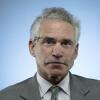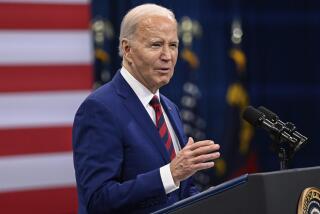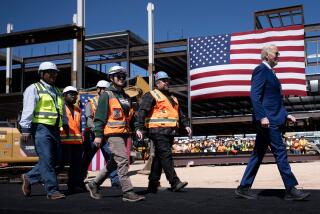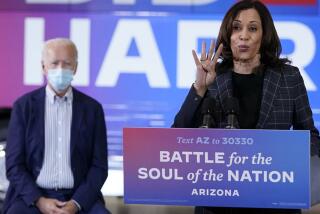Obama conquered the West for Democrats, but now it’s back in play
When President Obama claimed the Democratic nomination en route to the White House, he planted his party flag in this Rocky Mountain capital, vowing to end Washington’s dysfunction and find elusive consensus around issues such as immigration, guns and abortion.
Running as a different breed of Democrat — one more pragmatic and sensitive to the unbridled ethos of the region — Obama captured several Western states that the Republicans had won four years earlier, and came surprisingly close in two others.
Afterward, there was heady talk among Democrats of making the Mountain West a reliable part of their presidential base, safely tucking Colorado and Nevada alongside the blue bastions of California, Oregon and Washington, and turning Republican-leaning Arizona and Montana into a pair of tossup states.
But after the last several contentious years, none of that has happened. If anything, the interior West has grown even more competitive, as Republicans rolled up big midterm victories last year in Colorado and Nevada. They kept single-party control of Arizona’s capital and, from all appearances, pushed Montana off the table for Democrats.
The ups and downs of Obama and his party, the Republican comeback after two losing presidential campaigns, and the demographic changes remaking the face of the country have been broadly writ across the Rocky Mountain West, and what happens here could go a long way toward deciding which party wins the White House in 2016.
With no candidate hailing from the region, and no special affinity for likely Democratic nominee Hillary Rodham Clinton or any one of the Republican hopefuls, the fight is likely to be close, especially in Colorado, which has lately seen more political upheaval — shifting control of the state Senate, a pair of lawmakers recalled in a fight over guns, a rural secession movement — than just about any state.
Even Obama supporters, including some who helped put him in the White House, say he has fallen short of the goals set forth that August 2008 night in Denver, and of the political aspirations that followed. Washington appears more dysfunctional than ever, immigration, guns and abortion remain political flashpoints and the national party is still viewed in much of the libertarian-leaning West with the same degree of suspicion.
“As a candidate there was more hope for Obama,” said Dave Hunter, a veteran Democratic strategist in Montana, which Obama came close to winning in 2008, only to lose badly four years later. “But the reality, once he became president, was that he looked more like a typical Democrat than many people thought he was going to be.”
Seen from a broad view, the conversion of the Rocky Mountain West to a presidential battleground constitutes one of the big Democratic achievements of this young century, limited though it may be.
For decades, the interior West was solidly Republican territory, the land of white conservatism, Barry Goldwater and the Sagebrush Rebellion. As recently as 2004, Democrats had failed to carry a single Rocky Mountain state, capping a generation of near-total futility.
Obama not only broke through with his 2008 victories but pushed New Mexico, a former swing state, firmly into the Democratic column, where it seems likely to stay in 2016.
However, the opportunity for a wider, more lasting shift in presidential preferences — what one Obama advisor called “a fresh start” for Democrats in the vast region — dissipated with surprising swiftness.
Although the president carried the same Rocky Mountain states in 2012 that he won in 2008, his share of the vote fell in every one. He didn’t even bother to compete in Arizona.
Some blame his political difficulties on racism, particularly among rural Westerners, and a misleading campaign by conservatives, who they say set out to demonize Obama from the start by falsely portraying him as a left-wing extremist. They blocked progress, the president’s defenders say, even on issues such as immigration reform that enjoyed broad, bipartisan support.
“It is the hysteria and distortions of the right-wing media and Koch brothers apparatus and Republican officeholders that have polarized and alienated some,” Paul Harstad, a Colorado-based pollster who conducted research for both of the president’s campaigns, said in an email. “This is the same crowd that blindly denies climate change, appeals to bias against minorities and gays, doubts Obama’s citizenship and legitimacy and often won’t even affirm evolution.”
But even some defenders lay a portion of the blame on Obama and his policies, especially the enactment of sweeping healthcare legislation, which they said did more than anything to undermine his image as a less activist, more moderate style of Democrat — especially after the law’s botched rollout. Floyd Ciruli, a nonpartisan Denver pollster who has charted decades of Colorado public opinion, said Obama’s support collapsed during the fight over healthcare and, though he carried the state in his 2012 reelection campaign, never recovered.
“It glommed onto a lot of fears people have in the West about federal intrusion,” said Mike Stratton, a native Coloradan and longtime Democratic strategist. “From there it became part of a larger narrative, about big government and the IRS and Obama supposedly coming to take away your guns.”
Democrats still enjoy one significant advantage in 2016: the rapidly changing demographics of the Rocky Mountain states.
The ranks of young and, especially, Asian American and Latino voters continue to grow, and those groups have leaned heavily Democratic in the last two presidential races.
Whether they vote in the same number and with the same degree of enthusiasm for Clinton — or for whomever is the Democratic nominee — “is the campaign’s $64-million question,” said Pete Ernaut, a Republican strategist in Nevada.
Dick Wadhams, a former Colorado Republican Party chairman, agreed. To win, he said, Republicans will have to nominate someone with greater appeal, especially among women and minorities, than John McCain or Mitt Romney, the party’s last two nominees.
“We can win with the right kind of candidates,” said Wadhams, who has fought within his party to expand the outreach to Latinos and other minorities and tone down some of the harsher rhetoric surrounding issues like immigration. “A candidate who represents the future, who can articulate a Republican agenda in a way that attracts voters and doesn’t repel them.”
Colorado Gov. John Hickenlooper, a Democrat who survived a tough 2014 reelection fight even as Republicans knocked off the state’s senior U.S. senator, Mark Udall, said the winner here will be the candidate who can best “navigate toward the middle,” regardless of party.
“We’re one-third Republican, one-third Democratic and one-third independent,” he noted in an interview. “There’s a lot of negotiation that has to go on.”
That, Hickenlooper said, is how things work in the West.
Twitter: @markzbarabak
More to Read
Get the L.A. Times Politics newsletter
Deeply reported insights into legislation, politics and policy from Sacramento, Washington and beyond. In your inbox three times per week.
You may occasionally receive promotional content from the Los Angeles Times.







